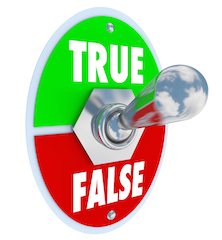Back in the dark ages of the Internet—say, around Y2K—financial advisor web sites were as primitive as Fred and Wilma Flintstone’s Bedrock home. Yes, they targeted worthwhile objectives such as:
• Broadcasting sales messages to prospects.
• Touting firm experience and credentials (AKA “chest thumping”).
• Scheduling prospects for upcoming seminars.
• Encouraging prospects to come in for initial consultations.
• Updating clients on practice news.
But those early websites were primarily “brochureware” sites; i.e., they simply migrated hard-copy brochures online. Since those early days, websites have become much more sophisticated. They are now designed to educate as well as to sell and to facilitate consumer engagement via social media, among other functions.
Their ultimate goal is still client acquisition, but their tactics are more magnetic (attracting clients with great content vs. broadcasting outbound sales messages) measurable (tracking prospect interactions with individual pages and responses to online calls to action), and relationship-building rather than transactional in nature. And underlying the best contemporary websites is the core objective of building trust, from which all positive results flow.
Trust is a complex phenomenon. Not surprisingly, designing a website to enhance it is not a simple proposition. It doesn’t depend on flicking a single switch, but rather incorporating multiple factors that establish advisor credibility and consumer trust.
At the National Ethics Association, we call these factors the PACT Trust Model. It stands for:
Professionalism
Authority
Credibility
Transparency
To foster credibility and trust, a financial advisor website must convey all of these attributes in order to be successful. Let’s define each one and then list the features that produce the desired attributes. Ready?
Professionalism: Like beauty, professionalism can be hard to define, but we know it when we see it. In our opinion, an advisor website is professional when it harmoniously balances function and form. On the first count, it should be easy to use and provide the features and information site visitors find helpful. And on the second, its design should be appealing to the eye, while projecting credibility and competence.
Following are some tactics that will enhance the perceived professionalism of your site:
• Use an attractive, yet simple, page design that projects financial strength, reliability, and conservatism.
• Make sure all content has depth and is free of grammar and syntax errors.
• Use content to educate prospects, not just promote your firm. Content should also be relevant to important financial issues, demographics, and client “money personalities.”
• Publish content regularly so your site doesn’t appear outdated
• Use a professional photographer to shoot business portraits of firm principals and staff. Avoid using low-quality illustrations or low-resolution photos downloaded from the web.
• Make it easy for people to contact you from your website (make “Contact” the last link on each page’s navigation menu).
• Avoid old-style blinking banners or annoying Flash intro pages or popups.
• Make sure every feature works as promised. Periodically check your site for dead links or non-functional forms that will convey the wrong impression.
Authority: This refers to the expertise you deploy to solve client problems. Your website must convince people at a glance that you know what you’re talking about and can deliver on your promises. To that end, it must function as an expertise hub that establishes authority as quickly as possible. Here are some specific tactics that will help:
• Craft a detailed “About Us” page. It should include a comprehensive discussion of your industry experience, professional competence, license types and regulatory bodies, and certifications. Also describe in detail your client types, and product/service specialties. Finally, tell “the story” of your business: how and when it began, how it has evolved, and where it’s headed.• Don’t just claim authority (hyping); demonstrate it by sharing useful information at every opportunity on your site.
• Publish client testimonials (if allowed by your license) as expertise proof points.
• Establish a blog on your website in order to explain key insurance/investment strategies and tools and to describe successful client outcomes (without identifying client names).
• If you refer clients to outside experts such as lawyers and attorneys, highlight that network prominently on your website. The quality of those individuals will reflect positively on your own authority.
• Display links to articles you’ve written for trade and consumer publications
Credibility: This attribute may well be the most important of all. Unless your site encourages people to believe in you—and to trust you—all will be for naught. Credibility flows from the things you say about yourself, as well as the things respected third parties say about you. It also results from including respected trust badges on your site, reflecting your ethical business practices and quality operating procedures. The following actions will help you establish the credibility you need to be a successful advisor in this industry:
• Use an appropriate Internet domain name and e-mail accounts that include your company’s name. Don’t use free accounts such as Yahoo or Google, which will mask your company name.
• When speaking about yourself, avoid hype and exaggeration. Don’t claim expertise you don’t have, and don’t make promises you can’t keep.
• Don’t misrepresent your products or services in your written or video content, and don’t publish content that intimidates or strikes fear in the hearts of your clients. Always strive to ground your content in truth and objectivity.
• Highlight all professional organizations you belong to, and state that you subscribe to their codes of ethics (and provide links to those codes).
• Join third-party organizations that provide ratings based on company performance or customer relations (example: the Better Business Bureau or McAfee Secure) or those that attest to your clean record (example: the National Ethics Association’s “Certified Background Checked” badge).
Transparency: Going beyond mandated disclosures sends a powerful message: that you have nothing to hide. And since consumers view transparent advisors much more favorably, being open is a strong differentiator. Here are some tips to consider implementing if you haven’t yet:
• Make sure to adhere to all disclosures mandated by your financial-services license. But strive to go beyond this level in order to make a stronger impression with prospects.
• Publish a “values statement” or manifesto on your web site, where you list the ethical principles your company believes in.
• Draft and post an official Code of Ethics, which defines your acceptable standards of professional conduct.
• Make sure your site incorporates the “voice of the owner” speaking candidly about the firm’s strengths and challenges.
• Publish photos and videos of employees that show your company’s unique culture in action.
• Post your company’s privacy policy, defining how you use client information and how you safeguard it.
• Share online reviews and other customer feedback with site visitors.
• Provide links to content posted on third-party social media sites.
• Build out your online social-media company profiles and make profile content consistent across multiple networks.
Consider putting yourself and other key employees through a professional background check. Then share the results of these checks on your web site.
So there you have it . . . our PACT approach to building trustworthy websites. How does your site compare with the items we discussed? Got most of the items covered? Then brainstorm further enhancements. Missing a lot of them? Then schedule a web upgrade project for the near future. Either way, you’ll be in a stronger position to establish ultimate consumer trust in the year ahead. Good luck!
For more information about ethical sales practices, please visit the National Ethics Association’s Ethics Center atethics.net. For information on affordable errors-and-omissions insurance for low-risk financial advisors, please visitEOforLess.com.












